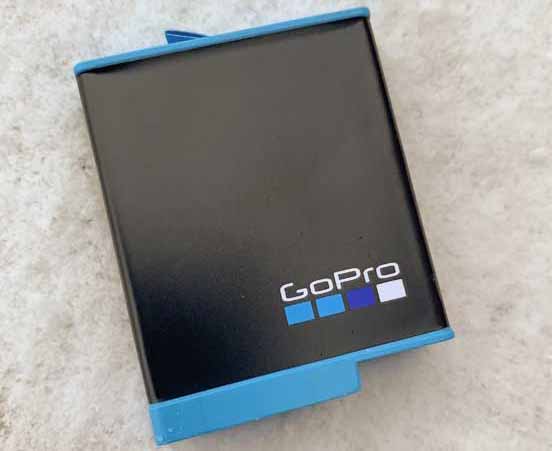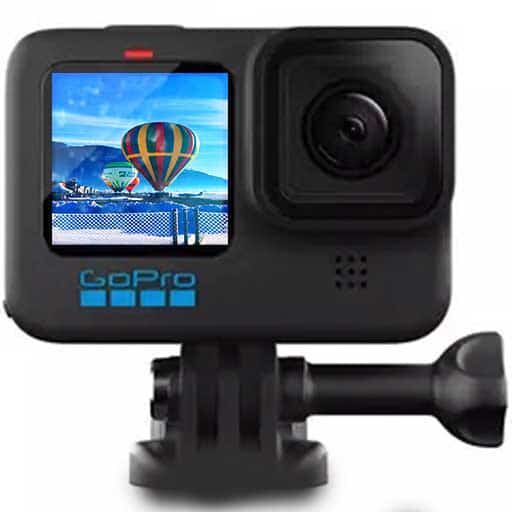How To Keep GoPro Warm When Skiing
In this article I’ll be sharing my experiences of how to keep GoPro warm when skiing throughout the day.
Not only do I share practical tips on keeping both the camera and battery warm. I also some useful technical information in regards to the camera battery itself.
Plus, I share best practices to follow while on the ski slopes. Follwing these practices ensure you’ve plenty of battery power to record a full day’s skiing.
Battery Capacity
It’s worth talking about battery capacity before we move onto the practical tips. I feel this helps you understand a little bit of the science behind how ambient temperature affects battery life.
GoPro cameras use rechargeable lithium-ion batteries, the following standard battery capacities are listed below for each model.
- Hero 7 Black and Hero 8 Black – 1220 mAh capacity
- Hero 9 Black – 1720 mAh capacity
- GoPro Hero 10 Black – 1720 mAh capacity
Note the abbreviation after the 4 digit numbers, “mAh” means milliamp Hour. This unit measures (electric) power over time.
In essence the more mAh the bigger the battery capacity. Therefore in most cases the longer the battery life which is good news when you’re on the ski slopes.
How The Cold Affects Battery Performance
Batteries produce an electric current when a connection is made between the positive and negative battery terminals.
A connection to the battery terminals starts a chemical reaction starts inside. Generating electrons which supply current from the battery to the camera.
Colder ambient air temperatures cause these chemical reactions to slow down. At lower temperatures a battery creates less current when compared to being in warmer temperatures.
A cold battery may even stop delivering enough current to keep up with the demand from the camera. However, a warmed battery will start to operate normally over time.
This is why you sometimes see your GoPro suddenly stop recording while skiing in really cold weather conditions. Especially when recording at higher video resolutions and frame rates.

Carry multiple batteries
Before heading out onto the slopes I tend to plan what I’m going to film during the ski day. Taking a moment to think about the style of filming using my GoPro cameras. Make sure all your batteries are fully charged overnight.
A basic plan of what footage you’re looking to capture helps you decide how many batteries you’re going to need.
Mounting the GoPro to a ski helmet and recording passively throughout the day will use battery power at an alarming rate.
Being more selective in what you film, for example shooting for a vlog or short documentary will mean less footage. This will in turn will require less battery power.
In essence, have a basic idea of the type of filming you’re aiming for while on the slopes. This will help you decide on how many batteries to carry with you skiing.
GoPro Enduro Extended Cold Weather Battery
As of late 2021 GoPro launched the Enduro Cold Weather Battery. Compatible with both the GoPro Hero 9 and Hero 10 Black.
The Enduro battery has certainly upped the recording time of both these newer camera models.
GoPro claims the battery improves cold-weather performance in temperatures down to 14°F (-10°C). With a 40% overall improvement in low temperature performance.
If you’re looking to snow ski this winter I’d definitely recommend checking out the Enduro battery if you’re a Hero 9 or 10 Black user.
Extended Battery Mode
Not long after the launch of the GoPro Hero 10 due to a number of users reporting poor battery performance and overheating issues. GoPro provided an update for the camera’s internal software.
Check your cameras firmware. The firmware v.1.16 which has some useful additional modes for battery saving efficiency is an important udpate.
Practical Tips To Keep Your GoPro & Batteries Warm
Lets now take a look at some ral world practical tips that you can practice for extended battery life in colder temperatures in the mountains.
Store Your GoPro Inside A Pouch
A low cost physical option that really does make a difference I’ve found is putting the camera inside a pouch. But not any ordinary pouch.
Available now are thermal insulated pouches or capsules as some people call them to place electronic devices into, protecting them from extreme cold temperatures.
Currently there are many brands of pouches to choose from on the market. Phoozy being one of the current leading brands. Their products are made from technology adapted from spacesuits used to protect astronauts from extreme temperatures.
In practice a thermal pouch definitely makes a considerable difference to keeping your GoPro batteries warm while skiing in colder conditions.
Store Inside a Jacket Pocket
An alternative to keeping your GoPro inside a thermal pouch is to carry the camera along with the batteries inside an insulated ski jacket pocket.
Ski jacket insulation traps warm air generated from your body which warms the camera after a relatively short time once placed inside the jacket. For extra warmth jackets with fleece linings offer added cold protection.
In really cold weather skiing a down filled ski jacket provides extra warmth compared to jackets with synthetic insulation.
Placing the camera into a jacket pocket between ski runs helps to stop the electronics inside the camera from getting too cold and thus shutting down while recording video footage when skiing.
Use chemical hand warmer inside a sock
Chemical hand warmers of the disposable type can provide up to 10 hours of heat once activated.
Warmers work by generating heat with a combination elements are exposed to air. Iron, water, activated carbon, vermiculite, cellulose, and salt. The iron oxidizes causing a chemical reaction that creates heat.
A word of caution here. I suggest placing the chemical hand warmer inside a ski sock rather than have the warmer directly in contact with the camera and lithium batteries in particular.
Always check frequently that the warmer and camera are not getting too hot while stored either inside a ski jacket pocket or daypack.
Wear A Backpack Or Daypack
This isn’t going to be for everyone. I’d suggest wearing a pack if you are a confident parallel skier on red marked ski pistes.
Wearing a backpack or daypack can to a degree affect your balance so for this reason as I outlined above, I would suggest proficient skiers only use this method of carrying a GoPro.
The daypack is ideal for piste skiing. You don’t need a huge pack, 15 litres capacity is plenty to carry all your camera gear, mountain safety kit, plus food and drink if necessary.
Having a daypack on the piste opens up a lot of additional ways to reduce the effect cold has on camera gear and batteries.
Let’s now take a look at several additional options for those who decide to wear a pack.
Carry USB charger
First off you’ll need a small power bank to provide power to the charger. Anker is a company who specializes in small power banks of around 10,000 mAh so I’d suggest taking a look at their products.
Compact power banks are ideal to keep several batteries topped up. While a third battery inside a GoPro mounted to a ski helmet for instance.
Plug the battery charger into the power bank via USB and you’ll have plenty of power all day while on the slopes.
Use An Electronic Hand Warmer
If you’re planning on going back country skiing then an additional way of extending filming time is to carry a high capacity hand warmer.
10,000mAh capacity can provide continuous heating for up to 15 hours in ideal conditions.
A premium level USB hand warmer has at least three temperature levels. Setting the level according to how cold it is will keep the daypack warm inside.
Placing your camera gear inside a daypack compartment with an electric hand warmer will reduce the effects cold ambient temperatures have on gear when in the mountains during the winter months.
Final Thoughts
Taking a moment to conclude, the first task is to carry out best practices in terms of making sure the firmware is the latest version on your GoPro.
Connecting the camera to the official GoPro Quik app will ensure the camera is running the latest battery saving firmware software.
Practical solutions
In practical terms, having the camera and spare batteries inside your ski jacket pocket will help a great deal in keeping the cold out of the camera’s internal electronics.
Adding a thermal pouch to your skiing kit to store the GoPro inside while on the ski slopes for extra cold weather protection is one of the simplest solutions.
I hope you have found this guide useful. These are my own personal tips on how I keep all my GoPro cameras fully functioning throughout a ski day.
Drop me a comment below if you have found this guide useful or you have any additional ideas on the subject.
Stay safe out on the mountains and happy skiing.






